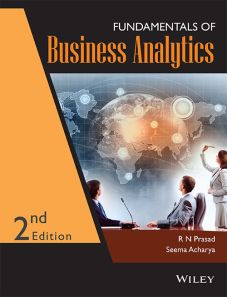Fundamentals of Business Analytics, 2ed
ISBN: 9788126563791
428 pages
Publication Year: 2016
eBook also available for institutional users
For more information write to us at: acadmktg@wiley.com

Description
The book promises to be a single source of introductory knowledge on business intelligence which can be taught in one semester. It will provide a good start for first time learners typically from the engineering and management discipline. Business Intelligence subject cannot be studied in isolation. The book provides a holistic coverage beginning with an enterprise context, developing deeper understanding through the use of tools, touching a few domains where BI is embraced and discussing the problems that BI can help solve. It covers the complete life cycle of BI/Analytics project: Covering operational / transactional data sources, data transformation, data mart / warehouse design-build, analytical reporting and dashboards.
Foreword
Preface
Acknowledgments
About the Authors
1 Business View of Information Technology Applications
1.1 Business Enterprise Organization, Its Functions, and Core Business Processes
1.2 Baldrige Business Excellence Frameworks (Optional Reading)
1.3 Key Purpose of using IT in Business
1.4 The Connected World: Characteristics of Internet-Ready IT Applications
1.5 Enterprise Applications (ERP/CRM, etc.) and Bespoke IT Applications
1.6 Information Users and Their Requirements
2 Types of Digital Data
2.1 Introduction
2.2 Getting into “GoodLife” Database
2.3 Getting to Know Structured Data
2.4 Getting to Know Unstructured Data
2.5 Getting to Know Semi-Structured Data
2.6 Difference between Semi-Structured and Structured Data
3 Introduction to OLTP and OLAP
3.1 OLTP (On-Line Transaction Processing)
3.2 OLAP (On-Line Analytical Processing)
3.3 Different OLAP Architectures
3.4 OLTP and OLAP
3.5 Data Models for OLTP and OLAP
3.6 Role of OLAP Tools in the BI Architecture
3.7 Should OLAP be Performed Directly on Operational Databases?
3.8 A Peek into the OLAP Operations on Multidimensional Data
3.9 Leveraging ERP Data Using Analytics
4 Getting Started with Business Intelligence
4.1 Using Analytical Information for Decision Support
4.2 Information Sources Before Dawn of BI?
4.3 Definitions and Examples in Business Intelligence, Data Mining, Analytics, Machine Learning, Data Science
4.4 Looking at “Data” from Many Perspectives
4.5 Business Intelligence (BI) Defined
4.6 Why BI? How Can You Achieve Your Stated Objectives?
4.7 Some Important Questions About BI - Where, When and What
4.8 Evolution of BI and Role of DSS, EIS, MIS, and Digital Dashboards
4.9 Need for BI at Virtually all Levels
4.10 BI for Past, Present, and Future
4.11 The BI Value Chain
4.12 Introduction to Business Analytics
5 BI Definitions and Concepts
5.1 BI Component Framework
5.2 Who is BI for?
5.3 BI Users
5.4 Business Intelligence Applications
5.5 BI Roles and Responsibilities
5.6 Best Practices in BI/DW
5.7 The Complete BI Professional
5.8 Popular BI Tools
6 Basics of Data Integration
6.1 Need for Data Warehouse
6.2 Definition of Data Warehouse
6.3 What is a Data Mart?
6.4 What is then an ODS?
6.5 Ralph Kimball’s Approach vs. W.H. Inmon’s Approach
6.6 Goals of a Data Warehouse
6.7 What Constitutes a Data Warehouse?
6.8 Extract, Transform, Load
6.9 What is Data Integration?
6.10 Data Integration Technologies
6.11 Data Quality
6.12 Data Profiling
7 Multidimensional Data Modeling
7.1 Introduction
7.2 Data Modeling Basics
7.3 Types of Data Model
7.4 Data Modeling Techniques
7.5 Fact Table
7.6 Dimension Table
7.7 Typical Dimensional Models
7.8 Dimensional Modeling Life Cycle
8 Measures, Metrics, KPIs and Performance Management
8.1 Understanding Measures and Performance
8.2 Measurement System Terminology
8.3 Navigating a Business Enterprise, Role of Metrics and Metrics Supply Chain
8.4 “Fact-Based Decision Making” and KPIs
8.5 KPI Usage in Companies
8.6 Where do Business Metrics and KPIs Come From?
8.7 Connecting the Dots: Measures to Business Decisions and Beyond
9 Basics of Enterprise Reporting
9.1 Reporting Perspectives Common to All Levels of Enterprise
9.2 Report Standardization and Presentation Practices
9.3 Enterprise Reporting Characteristics in OLAP World
9.4 Balanced Scorecard
9.5 Dashboards
9.6 How Do You Create Dashboards?
9.7 Scorecards vs. Dashboards
9.8 The Buzz behind Analysis…
10 Understanding Statistics
10.1 Role of Statistics in Analytics
10.2 Data, Data Description and Summarization
10.3 Statistical Tests
10.4 Understanding Hypothesis and t-Test
10.5 Correlation Analysis
10.6 Regression
10.7 ANOVA
10.8 The F-Test
10.9 Time Series Analysis
11 Application of Analytics
11.1 Application of Analytics
11.2 Analytics in Industries
11.3 Widely Used Application of Analytics
12 Data Mining Algorithms
12.1 Association Rule Mining
12.2 k-Means Clustering
12.3 Decision Tree
13 BI Road Ahead
13.1 Understanding BI and Mobility
13.2 BI and Cloud Computing
13.3 Business Intelligence for ERP Systems
13.4 Social CRM and BI
Unsolved Exercises
Glossary
Index

